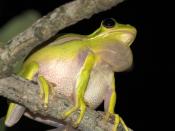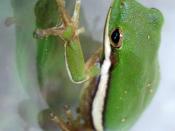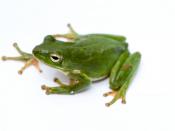Classification
÷Kingdom: Animalia
÷Phylum: Chordata
÷Class: Lissamphibia
÷Order: Anura
÷Family: Hylidae
÷Genus Hyla
÷Species: Hyla cinerea
Geographic Range
Nearctic: Delaware, eastern Maryland and Virgina, eastern North and South Carolina, southern Georgia, all of Florida, Alabama west to eastern Texas,and extending up the Mississippi Valley to extreme southern Illinois. Possibly northeastern Mexico (Conant 1975).
^ Physical Characteristics
Usually bright green, but an individuals color can vary from greenish-gray (when dormant during cool weather) to yellowish green (males when calling). Often has a white or yellowish stripe running down the body on either side, but the length and width of the stripe varies widely between individual, and is absent in some populations. Has the long legs and rounded toepads characteristic of treefrogs. They eyes are often golden-brown (Conant 1975).
^ Natural History
^ Food Habits
Eats insects and other small invertebrates. Sometimes found on houses around windows or outside lights, where it pursues the insects attracted to the light (Conant 1975).
^ Reproduction
This frog breeds from April 15 to August 15. The condition of the weather is a controlling factor in determining when, within this period, breeding actually occurs. Males croak and call to attract females. When their eggs are mature, the females enter the water and are clasped by the males in the process called amplexus. As the female lays the eggs, the male discharges seminal fluid containing sperm over the eggs to fertilize them. After fertilization, the jelly layers absorb water and swell. The black or brownish and white or cream eggs are in small packets or films at or near the surface, attached to floating vegetation. The outer envelope is poorly defined, becoming part of the mass. The tadpole is medium, 1 3/5 inches, its tail long and pointed, its body green with a sulphur or ivory stripe...


